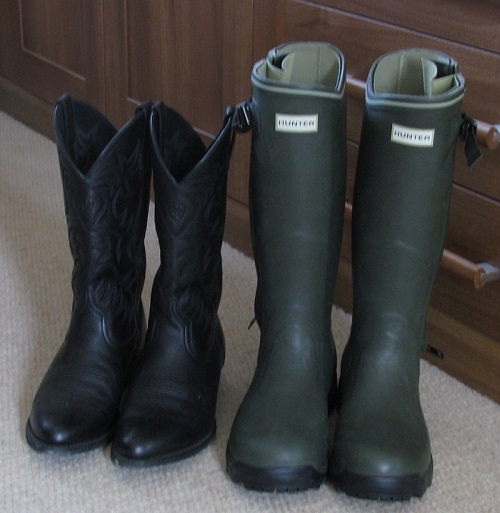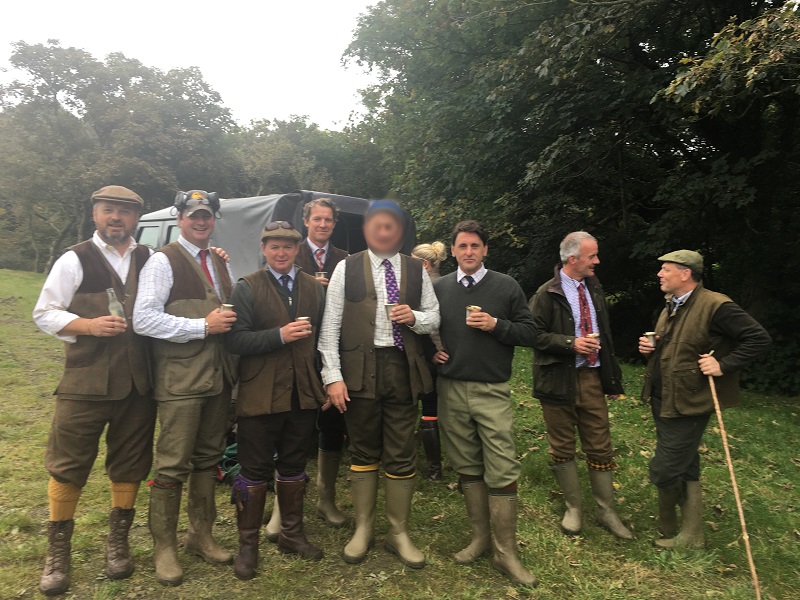Allow me to present an essential difference between boots as worn in the western U.S.A., and boots as worn in western Britishland:

Now let me explain why the ugly green ones on the right are not an affectation in These Yerrrr Parrrrts (as they call it here).
For most of my trip thus far there has not been a drop of rain fallen on my head. At least, not while I’ve been awake. So all my excursions have been dry, so to speak, and I’ve even been able to wear my Minnetonka moccasins (Kim’s go-to footwear) on a couple of shopping trips.
Then last night it rained — buckets, apparently — but I barely noticed it because I was sunk in semi-drunken slumber after Mr. FM and I had semi-indulged, so to speak. Today dawned bright and clear, but hidden underneath the oh-so green grass was… mud.
Good grief. It wasn’t just yer everyday sandy Texas mud; oh no, this was vile, clingy, chalky mud, the kind that needs not washing off but chiseling off if allowed to dry on the shoes. Anyway, after but a few steps in this stuff, my boots had completely disappeared into snowshoe-looking things of brownish gunk — it took the shoe boy almost an hour to clean it off (and if you look closely, you can still see a trace or two on the soles of my cowboy boots; I dare not tell Mrs. FM of this shortcoming or else the hapless youth will be flogged again).
Clearly, one needs a different kind of boot out here, so Mr. FM took me “wellie-shopping” at an emporium known as “Countrywide” which caters to the farm- and country-folk. And this was how I knew I was in Hardy Country.
You know how in Shepler’s Western Wear stores there’s an entire section dedicated to cowboy boots of all shapes and styles? That’s Countrywide’s policy towards Wellington boots (as rubber rain boots are known in Britishland). Yikes. And just like cowboy boots, wellies range in price from $100 a pair to $500 — and Mr. FM pointed out that “bespoke” wellies can demand still more than that.
I decided to go for fit over price: my sturdy calves (“more like full-grown bulls”, as my old dad once said) have given me trouble with tall boots all my life — but wonderfully, the wellies which fit me best were a “budget” brand which cost me only about $120, and are the ones featured in the pic above.
As for the bilious color of the things: Mr. FM assures me that hunter’s green is by far the most popular shade out in the field, as evidenced by this picture of his hunting party*, taken last year. Note the overwhelming choice of footwear:

So that’s okay, then.
*The bloke on the left (shirtsleeves rolled up, tieless and not wearing wellies) is apparently Lord Freddie Someone-Or-Other, whose family was given permission to be thus casually attired by the King, back in 1800 or something.

The attire is fascinating. We have foxhunting around here (live and drag), and folks dress for it, but I can’t imagine ever wearing anything like that pictured for actual game hunting. Even upland or water. Sharp looking, though.
Tradition harking back to the great Victorian driven pheasant shoots. I have participated in European Style Tower Pheasant Shoots here in the states that are a tiny bit like the Brits and they were great fun. I understand the the wool tweeds with neck tie and rubber boots all make sense in that climate and shooting from assigned position which would only be better with a matched set of London side x sides and a skillful loader.
A good friend of mine here in the Texas Hill Country is a retired 3 star Air Force General and he was assigned to some sort of NATO position in England in the 1990’s. His wife told me that she had to buy him the full clothing setup, maybe what the Brits would call kit, when he was invited to take part in a pheasant shoot in Scotland. He was not a shot gunner and said he shot rather poorly but he had a great time and came back with a brace of pheasant which he was told to hang in the garage for a bit. When they got rather gamey he gave them to his assigned driver who was delighted and my friend said there was no way he was going to eat stinky birds.
Kim, I really enjoy reading your great, grand, adventures and I wish I were there. As for us we kick off the hunting season in Texas with our Dove Eve Dining in on September 1 and our Dove Day shoot on September 2 in Abilene, Texas when 20 some odd of us gather as we have for over 20 years. It is a poor cousin to your hunting experience but it’s what we have and we would love to have you join us next year if you are in Texas.
I had a pair of French-made Le Chameau (pl. Chameaux?) when I lived in Sweden. They were a birthday present, and cost the equivalent of $250 some 25 years ago. Awesome boots, high to the knee – not only did they have foam insulation, keeping my feet warm in the winter (even when traipsing through frigid boggy areas with the dog), but the rubber sort of sealed itself if you got snagged on barbed wire and such. Wonderful boots.
My BiL got them when I left Sweden to move to San Diego.
Those green Wellies look the same as what is sometimes sold here in the upper midwest for farm chores and outdoor work. Excellent in mud or shallow water, okay for snow if it’s not cold, for Minnesota values of cold, not so good for steep hillsides where a bit more ankle support is helpful.
(Minnesota isn’t cold until you can gauge the temperature by the sound of the snow squeaking underfoot)
My wife and I were stationed in England from ’80-’83. Completely fell in love with the place, the people, the charm, the history and the wingshooting (not so much the food). I was lucky enough to have been invited to “driven shoots” and even had several pieces of land where I was allowed to go “rough shooting”. I had all the standard kit: green wellies, cotton-waxed coat, pork pie hat, 16 bore T. Turner double gun (should have never sold that gun, but kids needed stuff). I’d spent so much time with my Brit friends, I began to pick up the accent. So much so that one evening at the pub whilst conversing with local I’d just met, he asked “how long have you been here?” Kim, your recent posts have brought back many a fond memory. Thank you.
As Fast Richard says, you can buy a similar product here, the sole difference (Sic) being that they are not generally insulated. The lack of insulation allows you to wear thin socks in the summer, and not sweat like an egyptian slave, and then move to wool and layers in the winter to protect you from the bone chilling cold. Nice boots for mucking out stalls and so forth, which is their common purpose, but I’ve hunted in mine. Have a pair in that same sickly green, made in the US, I bought at Tractor supply for $19.